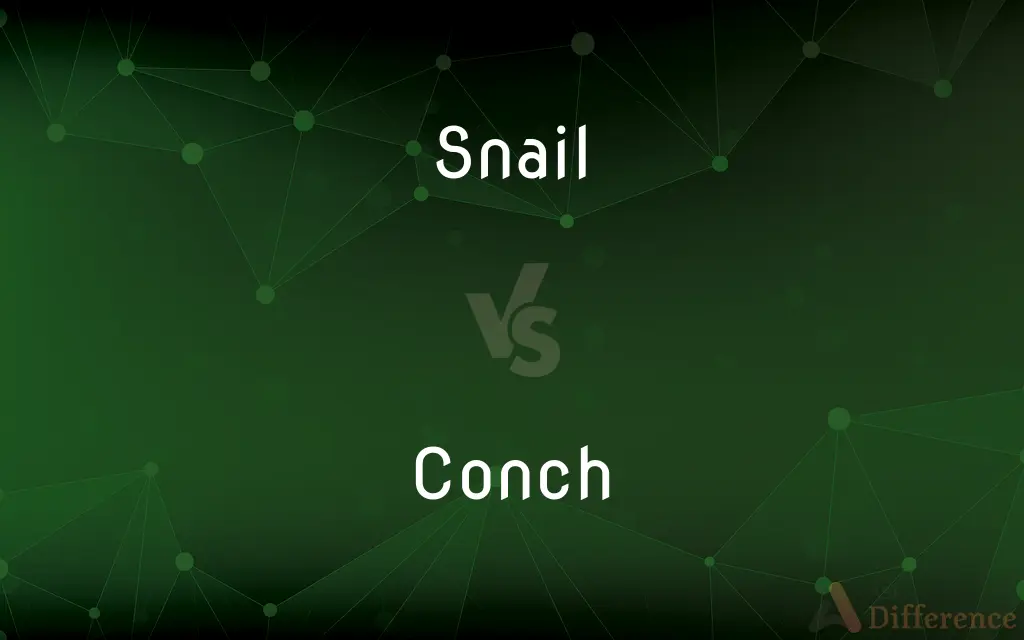Snail vs. Conch — What's the Difference?
By Urooj Arif & Maham Liaqat — Updated on March 29, 2024
Snails are known for their slow movement and variety of habitats, including land and water, while conches are a specific type of large sea snail with distinctive spiral shells.

Difference Between Snail and Conch
Table of Contents
ADVERTISEMENT
Key Differences
Snails encompass a wide range of gastropods with both terrestrial and aquatic species, characterized by their soft bodies and typically coiled shells. They can be found in gardens, forests, and bodies of water. In contrast, conches specifically refer to certain large marine snails, notable for their beautiful, spiraled shells, which are often prized for decoration and historically, as trumpets.
While snails are recognized for their slow movement and are often used metaphorically to denote slowness, conches are not typically associated with this trait despite also being slow movers. Instead, conches are more associated with their habitat in tropical and subtropical seas and their role in marine ecosystems. Whereas snails have a diverse diet, including plants, fungi, and detritus, conches are mainly herbivores, grazing on algae in sandy areas.
The shells of snails vary widely in size, shape, and color, reflecting their adaptation to different environments. In contrast, conch shells are specifically known for their large size, heavy and robust structure, and intricate patterns, which have made them objects of art and utility. While snail shells are used for protection and are generally modest in appearance, conch shells are also protective but are sought after for their aesthetic appeal and cultural significance.
Snails play various roles in ecosystems and human culture, acting as decomposers, pests, or even delicacies (as in the case of escargot). Conches, on the other hand, have a more specialized niche, with certain species being important in local economies for their meat and shells, which are used in crafts and as musical instruments.
Despite their differences, both snails and conches share the fundamental gastropod feature of a muscular foot, which they use for locomotion, and a radula, a unique organ for feeding. Their life cycles also include fascinating phenomena like the snail's ability to hibernate or aestivate and the conch's lengthy larval stage, which allows wide dispersal in ocean currents.
ADVERTISEMENT
Comparison Chart
Habitat
Land and freshwater/marine environments.
Marine environments, especially tropical seas.
Shell Appearance
Varied in size, shape, and color.
Large, robust, spirally coiled.
Diet
Herbivores, detritivores, some are carnivores.
Mainly herbivores, feeding on algae.
Movement
Known for slow movement.
Slow-moving but not commonly noted for speed.
Human Interaction
Garden pests, delicacies (e.g., escargot).
Shells used for decoration, meat consumed.
Ecological Role
Decomposers, part of the food web.
Part of marine ecosystems, sand cleaning.
Cultural Significance
Often seen as pests or in positive light as part of nature's beauty.
Prized for their shells, meat, and in cultural ceremonies.
Compare with Definitions
Snail
Can be a pest in gardens, eating plants.
Snails have been eating the leaves of my new plants.
Conch
Plays a significant role in marine ecosystems, especially in coral reef areas.
The conch grazes on algae, helping to clean the sand around coral reefs.
Snail
Utilizes a muscular foot for movement.
The snail used its muscular foot to glide along the wet ground.
Conch
A type of large marine snail with a heavy, spiral shell, found in tropical seas.
The conch shell washed up on the beach was beautiful and intact.
Snail
Capable of hibernation or aestivation.
The snail burrowed into the ground to aestivate during the dry season.
Conch
Shells are often used for decoration or as musical instruments.
He blew into the conch shell, producing a loud sound.
Snail
A mollusk with a soft body and typically a spiral shell, found both on land and in water.
The garden snail crept slowly across the leaf.
Conch
Conch meat is considered a delicacy in many cultures.
Conch fritters are a popular dish in Caribbean cuisine.
Snail
Served as a delicacy in some cultures (escargot).
He tried escargot for the first time at a French restaurant.
Conch
Has a lengthy larval stage that allows wide dispersal.
Conch larvae drift with ocean currents for weeks before settling and growing into adults.
Snail
A snail is, in loose terms, a shelled gastropod. The name is most often applied to land snails, terrestrial pulmonate gastropod molluscs.
Conch
Conch () is a common name of a number of different medium-to-large-sized sea snails. Conch shells typically have a high spire and a noticeable siphonal canal (in other words, the shell comes to a noticeable point at both ends).
Snail
Any of numerous aquatic or terrestrial gastropod mollusks that typically have a spirally coiled shell, retractile foot, and distinct head.
Conch
Any of various tropical marine gastropod mollusks chiefly of the family Strombidae, having edible flesh and a large spiral shell often with a flared lip.
Snail
A slow-moving, lazy, or sluggish person.
Conch
The shell of one of these gastropod mollusks, used as an ornament, in making cameos, or as a horn.
Snail
Any of very many animals (either hermaphroditic or nonhermaphroditic), of the class Gastropoda, having a coiled shell.
Conch
(Anatomy) See concha.
Snail
A slow person; a sluggard.
Conch
A marine gastropod of the family Strombidae which lives in its own spiral shell.
Snail
(engineering) A spiral cam, or a flat piece of metal of spirally curved outline, used for giving motion to, or changing the position of, another part, as the hammer tail of a striking clock.
Conch
The shell of this sea animal.
Snail
A tortoise or testudo; a movable roof or shed to protect besiegers.
Conch
A musical instrument made from a large spiral seashell, somewhat like a trumpet.
Snail
The pod of the snail clover.
Conch
(architecture) The semidome of an apse, or the apse itself.
Snail
(railroading) A locomotive with a prime mover but no traction motors, used to provide extra electrical power to another locomotive.
Conch
Synonym of concher
Snail
To move or travel very slowly.
Conch
To refine the flavour and texture of chocolate by warming and grinding, either in a traditional concher, or between rollers.
Snail
Any one of numerous species of terrestrial air-breathing gastropods belonging to the genus Helix and many allied genera of the family Helicidæ. They are abundant in nearly all parts of the world except the arctic regions, and feed almost entirely on vegetation; a land snail.
Conch
To play a conch seashell as a musical instrument, by blowing through a hole made close to the origin of the spiral.
Snail
Hence, a drone; a slow-moving person or thing.
Conch
A name applied to various marine univalve shells; esp. to those of the genus Strombus, which are of large size. Strombus gigas is the large pink West Indian conch. The large king, queen, and cameo conchs are of the genus Cassis. See Cameo and cameo conch.
Snail
A spiral cam, or a flat piece of metal of spirally curved outline, used for giving motion to, or changing the position of, another part, as the hammer tail of a striking clock.
Conch
In works of art, the shell used by Tritons as a trumpet.
Snail
A tortoise; in ancient warfare, a movable roof or shed to protect besiegers; a testudo.
They had also all manner of gynes [engines] . . . that needful is [in] taking or sieging of castle or of city, as snails, that was naught else but hollow pavises and targets, under the which men, when they fought, were heled [protected], . . . as the snail is in his house; therefore they cleped them snails.
Conch
One of the white natives of the Bahama Islands or one of their descendants in the Florida Keys; - so called from the commonness of the conch there, or because they use it for food.
Snail
The pod of the sanil clover.
Conch
Any of various edible tropical marine gastropods of the genus Strombus having a brightly-colored spiral shell with large outer lip
Snail
Freshwater or marine or terrestrial gastropod mollusk usually having an external enclosing spiral shell
Snail
Edible terrestrial snail usually served in the shell with a sauce of melted butter and garlic
Snail
Gather snails;
We went snailing in the summer
Common Curiosities
What are snails?
Snails are gastropods that have a soft body and a shell, found in a variety of environments including land, freshwater, and marine ecosystems.
Why are conch shells so valued?
Conch shells are valued for their size, beauty, and durability, making them popular for decorative purposes, in jewelry, and historically as tools or musical instruments.
Can all snails be eaten like conches?
Not all snails are edible or considered delicacies; some may be poisonous or unpalatable, whereas conches and certain land snails like those used for escargot are valued for their meat.
How are snails and conches adapted to their environments?
Snails have shells for protection and can hibernate or aestivate to survive harsh conditions, while conches have sturdy shells and a diet that supports their life in marine settings.
Do snails and conches serve the same ecological roles?
While both contribute to their ecosystems, their roles differ due to their habitats; snails can be decomposers or part of the food web in various environments, whereas conches mainly contribute to marine ecosystems.
What distinguishes a conch from other snails?
Conches are a specific type of marine snail known for their large, spiral shells and are found in tropical and subtropical seas.
What is the significance of conch meat?
Conch meat is a significant source of protein in many coastal and island communities, known for its role in dishes like conch fritters and conch salad.
Are conch populations at risk?
Some conch species face threats from overfishing and habitat loss, leading to conservation efforts to ensure their survival.
How do snails move?
Snails move by gliding along on their muscular foot, secreting mucus to help reduce friction.
Can snails and conches be kept as pets?
Yes, some species of snails are kept as pets or for educational purposes, though conches require specific marine conditions and are less commonly kept by hobbyists.
Share Your Discovery

Previous Comparison
Pumpernickel vs. Squaw
Next Comparison
Mochi vs. MochaAuthor Spotlight
Written by
Urooj ArifUrooj is a skilled content writer at Ask Difference, known for her exceptional ability to simplify complex topics into engaging and informative content. With a passion for research and a flair for clear, concise writing, she consistently delivers articles that resonate with our diverse audience.
Co-written by
Maham Liaqat















































